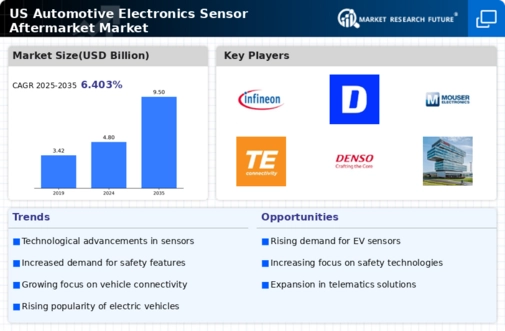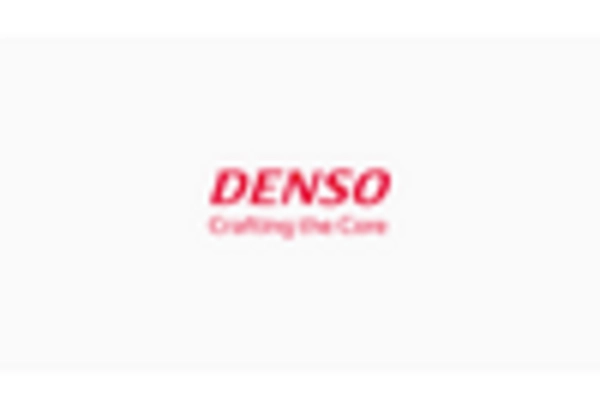Rising Vehicle Electrification
The automotive electronics-sensor-aftermarket market is experiencing a notable shift towards vehicle electrification. As more consumers opt for electric vehicles (EVs), the demand for specialized sensors that monitor battery performance, energy consumption, and thermal management is increasing. This trend is projected to drive the aftermarket sector, as existing vehicles are retrofitted with advanced electronic systems to enhance efficiency. According to industry estimates, the EV market is expected to grow at a CAGR of approximately 20% through 2025, which will likely boost the demand for aftermarket sensors. Consequently, manufacturers are focusing on developing innovative solutions that cater to the unique requirements of electric vehicles, thereby expanding their market presence in the automotive electronics-sensor-aftermarket market.
Growing Focus on Vehicle Safety
the automotive electronics-sensor-aftermarket market is increasingly focused on vehicle safety., which is driving demand for advanced sensor systems. With increasing regulatory requirements and consumer awareness regarding safety features, manufacturers are compelled to integrate more sophisticated sensors into vehicles. For instance, the market for collision avoidance systems, which rely heavily on sensors, is expected to grow significantly, with projections indicating a value of $30 billion by 2027. This heightened emphasis on safety is likely to lead to increased aftermarket sales as consumers look to enhance their vehicles with additional safety features. Consequently, the automotive electronics-sensor-aftermarket market is poised for growth as manufacturers respond to these evolving safety standards.
Expansion of the Connected Vehicle Ecosystem
The expansion of the connected vehicle ecosystem is reshaping the automotive electronics-sensor-aftermarket market. As vehicles become more integrated with digital technologies, the demand for sensors that facilitate connectivity is surging. These sensors enable features such as real-time diagnostics, remote monitoring, and vehicle-to-everything (V2X) communication. The connected car market is projected to reach $200 billion by 2025, indicating a substantial opportunity for aftermarket sensor manufacturers. This trend suggests that consumers are increasingly interested in enhancing their driving experience through connectivity, which may drive the demand for aftermarket solutions. As a result, the automotive electronics-sensor-aftermarket market is likely to benefit from this technological evolution.
Technological Advancements in Sensor Technology
Technological advancements are significantly influencing the automotive electronics-sensor-aftermarket market. Innovations in sensor technology, such as the development of MEMS (Micro-Electro-Mechanical Systems) sensors, are enhancing the accuracy and reliability of vehicle diagnostics. These advancements enable better monitoring of vehicle performance, leading to improved safety and efficiency. The market for MEMS sensors is projected to reach $10 billion by 2026, indicating a robust growth trajectory. As vehicles become increasingly complex, the need for sophisticated sensors that can provide real-time data is paramount. This trend is likely to drive aftermarket sales as consumers seek to upgrade their vehicles with the latest technology, thereby creating opportunities for manufacturers in the automotive electronics-sensor-aftermarket market.
Increasing Consumer Preference for Customization
The automotive electronics-sensor-aftermarket market is also influenced by the increasing consumer preference for vehicle customization. As car owners seek to personalize their vehicles, the demand for aftermarket sensors that enhance performance and aesthetics is rising. This trend is particularly evident in the growing popularity of aftermarket modifications, such as performance tuning and advanced lighting systems. Market Research Future indicates that the aftermarket automotive accessories market is expected to reach $50 billion by 2026, suggesting a robust growth potential. This consumer inclination towards customization is likely to drive sales in the automotive electronics-sensor-aftermarket market, as manufacturers develop tailored solutions to meet diverse consumer needs.

















Leave a Comment